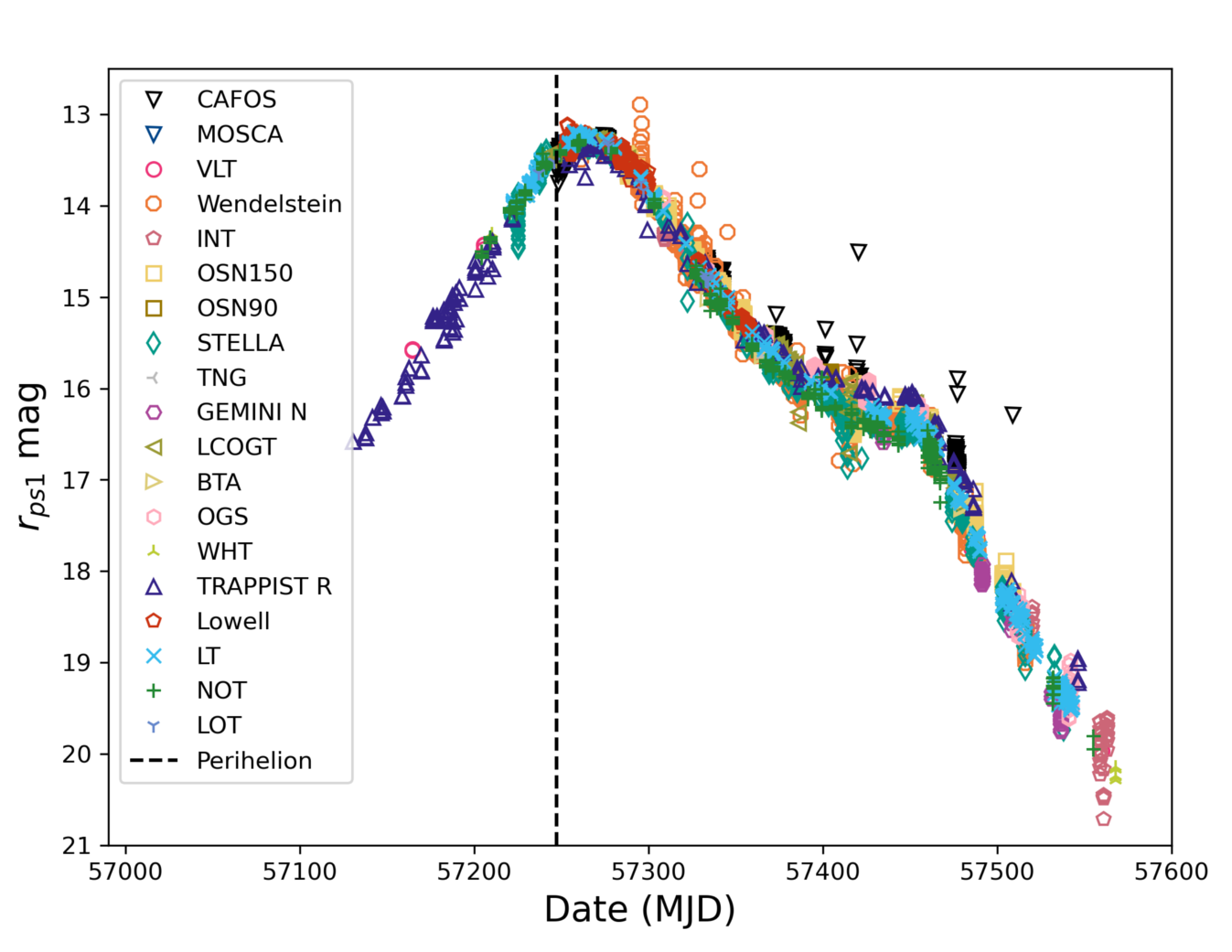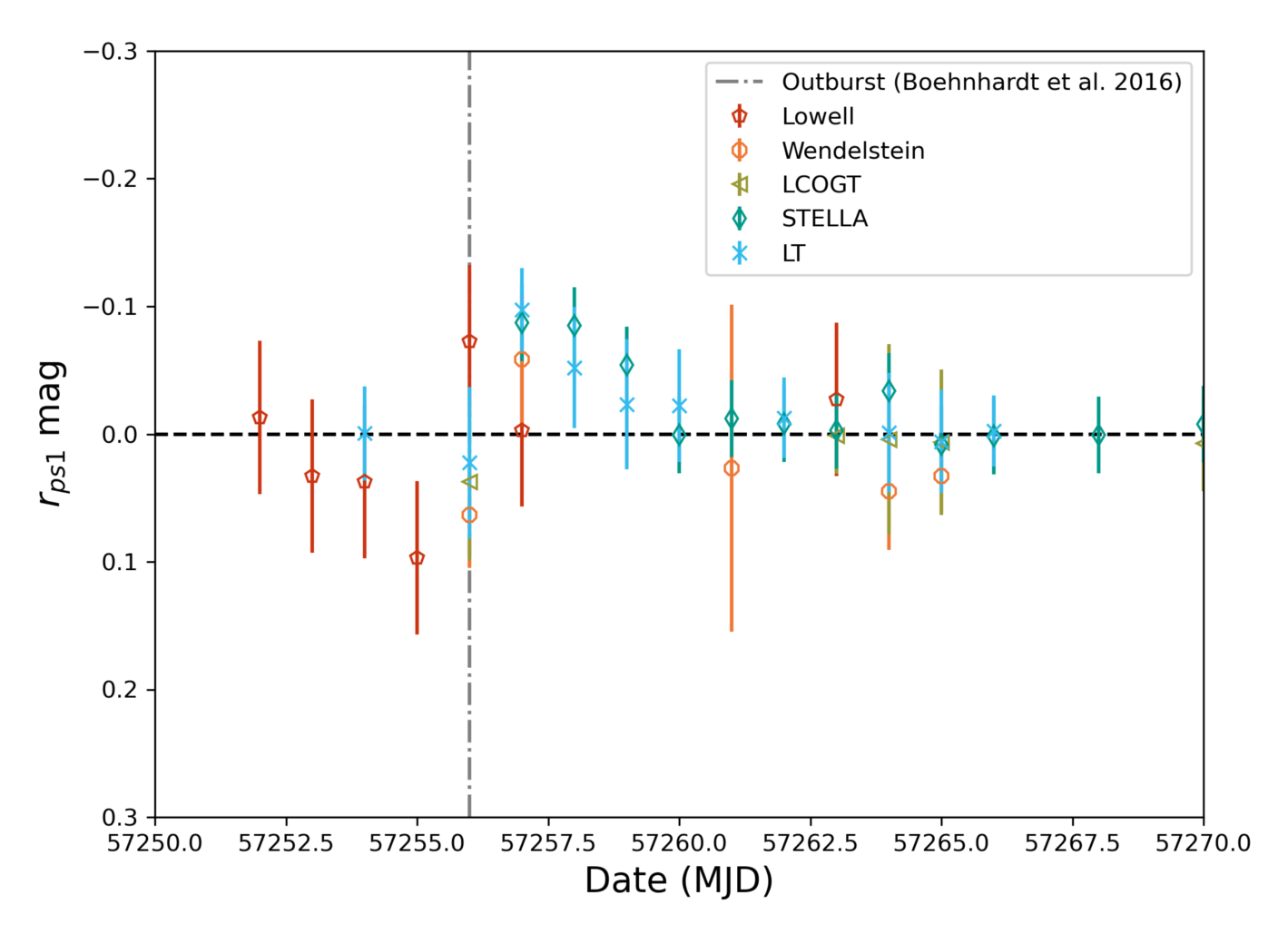Searching for Outbursts in the Ground-Based Photometry of 67P/Churyumov-Gerasimenko
- University of Edinburgh, Institute for Astronomy, School of Physics and Astronomy, United Kingdom
Comets are the primitive building blocks of the Solar System. In order to understand the extent of the pristine nature of comets, we must understand the mechanisms that affect their surfaces and comae – their activity.
Activity can be tracked in a variety of ways, such as observing dust production in the coma and tail. We can study the activity in a quantitative way through photometry of the reflected sunlight, as flux is proportional to the reflecting area of the dust lifted off the comet by its activity. Activity varies from comet to comet so we must try to distinguish whether these differences in activity are because of ageing or reflect primordial differences. Ageing refers to effects that have chemically or physically altered the nucleus since its formation and may cause a change in the activity. The most obvious of which is the production of comae and tails, caused by escaping gas and dust lifted off the surface of the comet. Other signs of activity include outbursts, where material is suddenly ejected into the coma, causing an immediate and rapid brightening in telescopic observation.
All processes that physically and chemically alter a cometary nucleus can be regarded as ageing. The ageing processes are too slow and irregular to become detectable during a single observation. When comets are observed over a number of Solar System returns some changes can be detected (Meech & Svoren 2004). As such, that evolution of comets is best studied on a statistical basis.
Distinguishing the effects of ageing from primordial differences is important since the wide range of formation scenarios should imply significantly different observational qualities. Once the differences are established, it will allow us to use the comets as time capsules of the chemical and physical conditions in the early Solar System.
67P/Churyumov-Gerasimenko is a Jupiter-family comet that was the target of the Rosetta mission, the first mission to successfully orbit and land a probe on a comet. This mission was accompanied by a large ground-based observing campaign, the photometry from the campaign had been calibrated approximately by Snodgrass et al. (2017) but we present a more rigorous and accurate calibration.
We have developed a pipeline to calibrate and measure photometry of comet 67P during its 2016 perihelion passage, making use of all visible wavelength imaging collected across a wide range of facilities. The pipeline calibrates the brightness to a common photometric system (Pan-STARRS 1) using background stars in the field via the calviacat program (Kelley & Lister 2019).
The pipeline has been successfully applied to our entire data set of 67P imaging. The compiled light curve of the r-band observations are presented in Figure 1. The results follow predictions based on observations in previous orbits (Snodgrass et al. 2013) and show no obvious deviations, indicating that 67P doesn’t show significant changes due to ageing from orbit-to-orbit.
We will present results of a search for small-scale variation in activity that could be related to outbursts measured in situ by the spacecraft (Vincent et al. 2016). From manual inspection of the light curve we have identified one significant outburst, shown in Figure 2. This corresponds to an outburst seen in the comet coma morphology on the morning of 22 August 2015 by Boehnhardt et al. (2016). The date and time of this event corresponds to an outburst seen by the NavCam instrument onboard Rosetta (Vincent et al. 2016). However morphological differences and descrepancies between the estimates of the origin location make it difficult to draw a definitive connection between these two events. But it also unlikely that these outubursts are completely unconnected to this larger morphological change, perhaps these small outbursts were contributing to some unseen larger activity event.
We have placed constraints on these small-scale outbursts and their detectability from Earth-based observations and we constrain how well global activity measures relate to local changes on the comet nucleus. The lessons learned from Rosetta can be applied to the wider comet population, many of which will never be visited directly and only ever observed from the ground.

Figure 1: The r-band light curve of 67P/Churyumov-Gerasimenko measured within a 10,000 km aperture.

Figure 2: Light curve of signs of an outburst with the underlying trend removed. A sudden increase in brightness with a fall off typical of outburst is seen on and after the night of 22 August 2015, marked by the dot-dashed line. This corresponds to a morphological change in the coma seen by Boehnhart et al. (2016).
References
Boehnhardt H. et al., 2016, MNRAS, 462, S376
Kelley M., Lister T., 2019, mkelley/calviacat, doi:10.5281/zenodo.2635840
Meech K. J., Svoren J., 2004, in Comets II. Univ. of Arizona, Tuscon, pp 317–335
Snodgrass, C. et al., 2013, A&A, 557, A33
Snodgrass, C. et al., 2017, Phil. Trans. R. Soc. A, 375, 2016024
Vincent, J.-B. et al., 2016, MNRAS, 462, S184
How to cite: Gardener, D. and Snodgrass, C.: Searching for Outbursts in the Ground-Based Photometry of 67P/Churyumov-Gerasimenko, Europlanet Science Congress 2022, Granada, Spain, 18–23 Sep 2022, EPSC2022-591, https://doi.org/10.5194/epsc2022-591, 2022.

